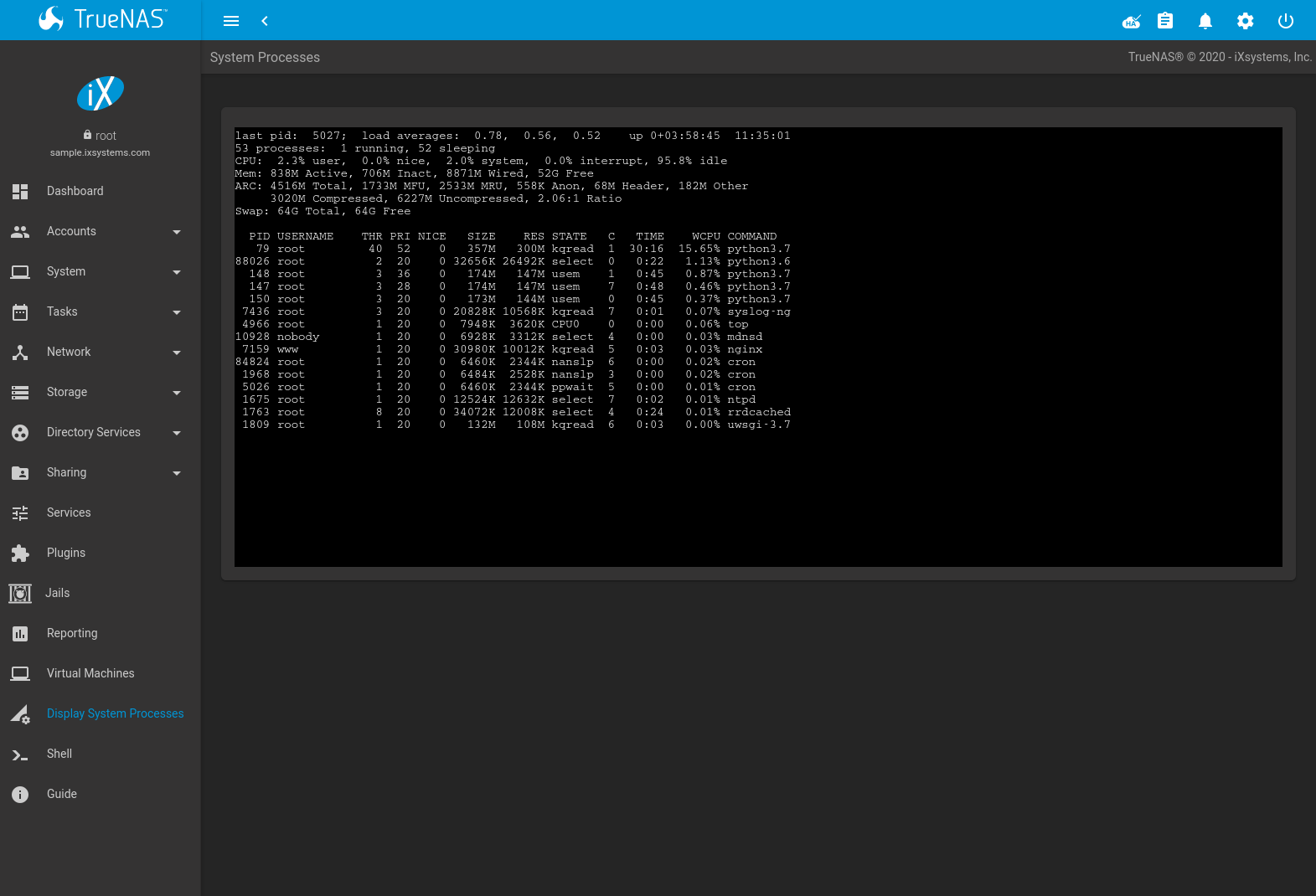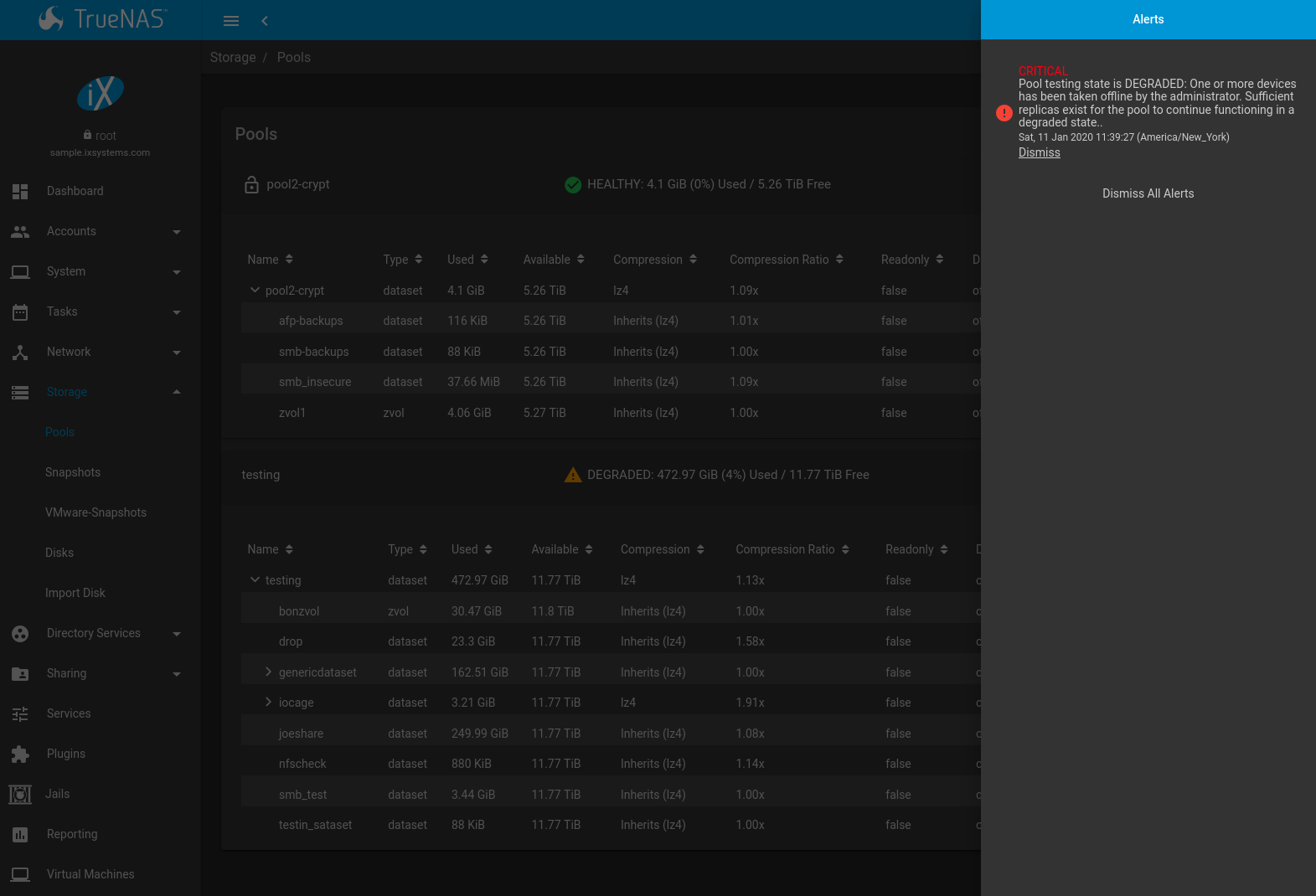18. Additional Options¶
This section covers the remaining miscellaneous options available from the TrueNAS® graphical administrative interface.
18.1. Display System Processes¶
Clicking Display System Processes opens a screen showing the output of top(1). An example is shown in Figure 18.1.1.

Fig. 18.1.1 System Processes Running on TrueNAS®
The display automatically refreshes itself. The display is read-only.
18.2. Shell¶
The TrueNAS® web interface provides a web shell, making it convenient to run command line tools from the web browser as the root user.

Fig. 18.2.1 Web Shell
The prompt shows that the current user is root, the hostname is
freenas, and the current working directory is ~, the home
directory of the logged-in user.
Note
The default shell for a new install of TrueNAS® is zsh. TrueNAS® systems which have been upgraded from an earlier version will continue to use csh as the default shell.
The default shell can be changed in . Click (Options) and Edit for the root user. Choose the desired shell from the Shell drop-down and click SAVE.
The Set font size slider adjusts the size of text displayed in the Shell. Click RESTORE DEFAULT to reset the shell font and size.
A history of previous commands is available. Use the up and down arrow
keys to scroll through previously entered commands. Edit the command if
desired, then press Enter to re-enter the command.
Home, End, and Delete keys are supported. Tab
completion is also available. Type a few letters and press Tab to
complete a command name or filename in the current directory. Right-
clicking in the terminal window displays a reminder about
using Command+c and Command+v or Ctrl+Insert and
Shift+Insert for copy and paste operations in the TrueNAS® shell.
Type exit to leave the session.
Clicking other web interface menus closes the shell session and stops commands running in the shell.
Note
Not all shell features render correctly in Chrome. Firefox is the recommended browser when using the shell.
Most FreeBSD command line utilities are available in the Shell.
18.3. Log Out, Restart, or Shut Down¶
The ⏻ (Power) button is used to log out of the web interface or restart or shut down the TrueNAS® system.
18.3.1. Log Out¶
To log out, click ⏻ (Power), then Log Out. After logging out, the login screen is displayed.
18.3.2. Restart¶
Click Restart shows the warning message in Figure 18.3.1.

Fig. 18.3.1 Restart Warning Message
If a scrub or resilver is in progress when a restart is requested, an additional warning asks if you wish to proceed. In this case, it is recommended to Cancel the restart request and to periodically run zpool status from Shell until it is verified that the scrub or resilver process is complete. Once complete, the restart request can be re-issued.
Click the Cancel button to cancel the reboot request. Otherwise, set Confirm and click Reboot to reboot the system. Rebooting the system disconnects all clients, including the web interface. Wait a few minutes for the system to boot. If the login screen does not appear, access the system using IPMI to determine if a problem is preventing the system from resuming normal operation.
18.3.3. Shut down¶
Clicking Shut down shows the warning message in Figure 18.3.2.

Fig. 18.3.2 Shutdown Warning Message
If a scrub or resilver is in progress when a shut down is requested, an additional warning will ask for confirmation to proceed. In this case, it is recommended to Cancel the shutdown request and to periodically run zpool status from Shell until it is verified that the scrub or resilver process is complete. Once complete, the shut down request can be re-issued.
Click the Cancel button to cancel the shutdown request. Otherwise, set Confirm and click SHUT DOWN to halt the system. Shutting down the system will disconnect all clients, including the web interface, and will power off the TrueNAS® system. If the system has High Availability (HA) with Failover enabled, the system failsover to the standby TrueNAS controller.
18.4. Alert¶
The TrueNAS® alert system provides a visual warning of any conditions that require administrative attention. The Alert icon in the upper right corner has a notification badge that displays the total number of unread alerts. In the example alert shown in Figure 18.4.1, the system is warning that a pool is degraded.

Fig. 18.4.1 Example Alert Message
Table 18.4.1 shows the icons that indicate notification, warning, critical, and one-shot critical alerts. Critical messages are also emailed to the root account. One-shot critical alerts must be dismissed by the user.
| Alert Level | Icon |
|---|---|
| Notification | |
| Warning | 肋 |
| Critical | |
| One-shot Critical | |
Close an alert message by clicking Dismiss. There is also an option to Dismiss All Alerts. Dismissing all alerts removes the notification badge from the alerts icon. Dismissed alerts can be re-opened by clicking Re-Open.
Behind the scenes, an alert daemon checks for various alert conditions, such as pool and disk status, and writes the current conditions to the system RAM. These messages are flushed to the SQLite database periodically and then published to the user interface.
Current alerts are viewed from the Shell option of the Console Setup Menu (Figure 2.2.1) or the Web Shell (Figure 18.2.1) by running midclt call alert.list. Alert messages indicate which High Availability (HA) TrueNAS controller generated the alert.
Notifications for specific alerts are adjusted in the Alert Settings menu. An alert message can be set to publish IMMEDIATELY, HOURLY, DAILY, or NEVER.
Some of the conditions that trigger an alert include:
- used space on a pool, dataset, or zvol goes over 80%; the alert goes red at 95%
- new ZFS Feature Flags are available for the pool; this alert can be adjusted in Alert Settings if a pool upgrade is not desired at present
- a new update is available
- hardware events detected by an attached IPMI controller
- an error with the Active Directory connection
- ZFS pool status changes from HEALTHY
- a S.M.A.R.T. error occurs
- the system is unable to bind to the WebGUI IPv4 Address set in
- the system can not find an IP address configured on an iSCSI portal
- the NTP server cannot be contacted
- syslog-ng(8) is not running
- a periodic snapshot or replication task fails
- a VMware login or a VMware-Snapshots task fails
- a Cloud Sync task fails
- deleting a VMware snapshot fails
- a Certificate Authority or certificate is invalid or malformed
- an update failed, or the system needs to reboot to complete a successful update
- a re-key operation fails on an encrypted pool
- an Active Directory domain goes offline; by default the winbindd connection manager will try to reconnect every 30 seconds and will clear the alert when the domain comes back online
- LDAP failed to bind to the domain
- any member interfaces of a lagg interface are not active
- a device is slowing pool I/O
- Rsync task status
- a scrub has been paused for more than eight hours
- a connected Uninterruptible Power Supply (UPS) switches to battery power, switches to line power, communication with the UPS is lost or established, the battery is low, or the battery needs to be replaced
- a Fibre Channel (FC) Host Bus Adapter (HBA) configured as an iSCSI target is not detected
- the interface which is set as critical for failover is not found or is not configured
- attached SATADOM has 20% or less lifetime remaining
- NVDIMM problems
- HA is configured but the connection is not established
- one TrueNAS controller of an HA pair gets stuck applying its configuration journal as this condition could block future configuration changes from being applied to the standby TrueNAS controller
- TrueNAS controllers do not have the same number of connected disks
- the boot volume of the standby TrueNAS controller is not HEALTHY
- 30 days before the license expires, and when the license expires
- the usage of a HA link goes above 10MB/s
- an IPMI query to a standby TrueNAS controller fails, indicating the standby TrueNAS controller is down
- Proactive Support is enabled but any of the configuration fields are empty
- ticket creation fails while Proactive Support is enabled
- if VMware failed to log in (usually preceding a VMware snapshot)
- if an unlicensed expansion shelf is connected
- if a USB storage device has been attached which could prevent booting or failover
- when the standby TrueNAS controller cannot be contacted
- when it is 180, 90, 30, or 14 days before support contract expiration
Note
If Proactive Support is enabled with Silver or Gold support coverage, and there is an internet connection, alerts which can indicate a hardware issue automatically create a support ticket with iXsystems Support. These alerts include a ZFS pool status change, a multipath failure, a failed S.M.A.R.T. test, and a failed re-key operation.